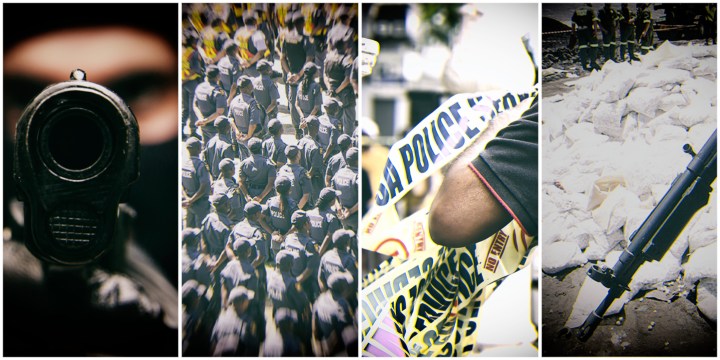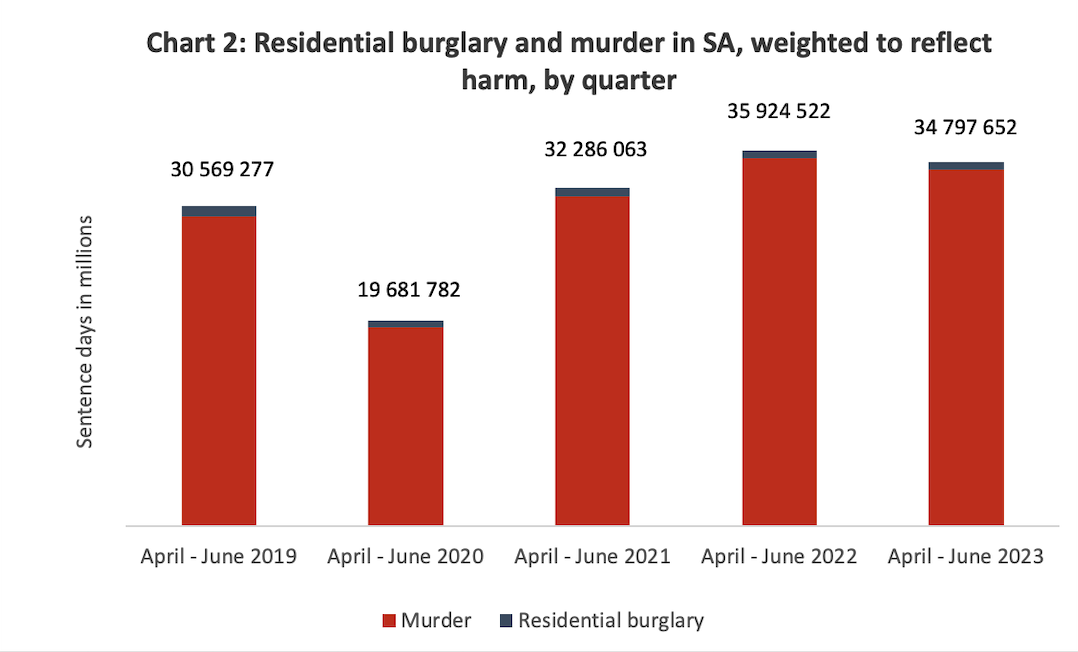ISS TODAY OP-ED
SA would benefit from crime harm index to monitor and target impact of violent offences

Not all crimes have the same impact, so police should prioritise reducing harm, not just the crime count.
Recently released police crime statistics show a 3% decline in murder for the second quarter of 2023 compared to last year. The number of murders dropped from 6,424 in April-June 2022 to 6,228 in April-June 2023.
In South Africa, 2022 was an exceptionally violent year. More people were killed in the first quarter of 2023 than in any other first quarter on record — besides 2022. Murder is our best measure of overall violence and the best single metric to identify priorities for police and government action.
But what about all the other types of crime — have they also decreased? In the first quarter of 2019, the South African Police Service (SAPS) recorded 402,023 incidents of what it calls “17 community-reported serious crimes”. This category encompasses all the main violent and property-related crimes, from murder to shoplifting. In the second quarter of 2023, 371,368 cases were recorded — 8% down from 2019.
So why have perceptions of safety and trust in police fallen over the same period that crime is dropping? Perhaps actual crime levels are staying the same or increasing, but fewer people are reporting incidents to the police.
Or crime could have reduced, but the number of incidents recorded doesn’t reflect the harm victims experience. Simple crime figures do not reveal whether public safety is getting better or worse in a particular area or time. For example, not each of the 17 types of crime in the SAPS’ ‘serious crime’ basket cause the same harm. Using a crime harm index can provide a more meaningful measure of the impact of crime on communities.
Crime harm index clarity
The principle behind a harm index is simple yet profound: not all crimes cause equal harm. A shoplifting incident doesn’t have the same societal impact as a violent assault or murder. Traditional crime metrics tend to treat them equally — summing incidents irrespective of their gravity. A harm index, however, provides a weighted measure based on the harm caused.
This idea was pioneered by evidence-based policing advocates at Cambridge University over a decade ago and has been introduced in several countries including England, Wales, New Zealand, Canada and Sweden. Each has modified it to fit their context. They have used different methods, but all have created weightings based on the sentencing guidelines or actual sentencing practices for each crime type.
This is a reliable and economical way to look at the true effect of criminal acts on society, and to target police and social interventions where and when harm is greatest. Because South Africa lacks clear, nationwide sentencing guidelines for each crime category, innovations will be needed to develop a crime harm index.
The index’s value can be shown with an example, using the SAPS crime figures and weightings from England and Wales (because South Africa lacks sentencing data for specific crimes). The weightings are based on sentencing guidelines for the minimum number of days’ imprisonment for a first offence before mitigating and aggravating factors are considered.
Between April and June 2023, the SAPS recorded 6,228 cases of murder and 36,808 cases of burglary at residential premises, totalling 43,036 incidents. In 2019, the comparable figures were 5,398 murders and 53,433 burglaries, totalling 58,831 cases. Combining these two offences into a single measure would suggest a significant improvement in crime levels over time (Chart 1).


This picture fails to capture that even a large drop in burglary — which is higher in volume but lower in seriousness — may not amount to improved public safety when stacked up against an increase in murder. To represent both the number and severity of crimes, we must apply a much higher weighting to murder than burglary.
The minimum sentencing guidelines from England and Wales are 19 days for burglary and 5,475 days for murder — the latter being the same as in South Africa. If each offence is weighted accordingly, the trend in Chart 1 changes dramatically. Instead of an improvement, public safety is worsening (Chart 2).
Public safety measure
Weighting crimes in terms of the harm they cause victims and society provides a more meaningful measure of public safety. This allows police to more accurately determine where to focus their limited resources for the most significant impact.
In his 2023 State of the Nation address, President Cyril Ramaphosa said police would “use more sophisticated data-driven methods to identify and target crime hot spots”. Applying a harm analysis would allow police to identify crime ‘harm spots’ rather than ‘hot spots’. Hot spots are areas with the highest volume of crime, whereas a harm spot looks beyond volume to the level of harm or negative impact that a crime causes.
South Africa’s police must prioritise reducing crime harm rather than crime count, and target crime harm spots rather than simply crime statistic-determined hot spots.
Developing and applying an official crime harm index could rationalise priorities and improve how the criminal justice system pursues its work. Police and prosecutors can be judged on their ability to process offenders for the most harmful offences rather than using broad categories like ‘contact’ or ‘property’ crime. Although the SAPS and National Prosecuting Authority recognise this, there is no objective measure of crime severity or a formal system to drive targeted criminal justice activities.
Applying this logic would also provide a simple, defensible formula that enables police and prosecutors to explain to politicians and the public why some places should be prioritised. This is a well-established necessity for effective policing and violence prevention. Police cannot be everywhere or do everything. They must focus on the people, places and times associated with the most significant harm.
To get there, the SAPS Crime Registrar and Research components must partner with government departments, experts, civil society and the private sector to create a South African crime harm index. With this in place, police and their partners can use their limited resources to have the greatest impact possible to improve safety. DM
Dr Andrew Faull, Senior Researcher, Dr Anine Kriegler, Senior Researcher and Sivenathi Mtiwejojo, Research Intern, Institute for Security Studies (ISS) Pretoria.
Research for this article was funded by the Hanns Seidel Foundation and Bavarian State Chancellery.
First published by ISS Today.















 Become an Insider
Become an Insider
Comments - Please login in order to comment.